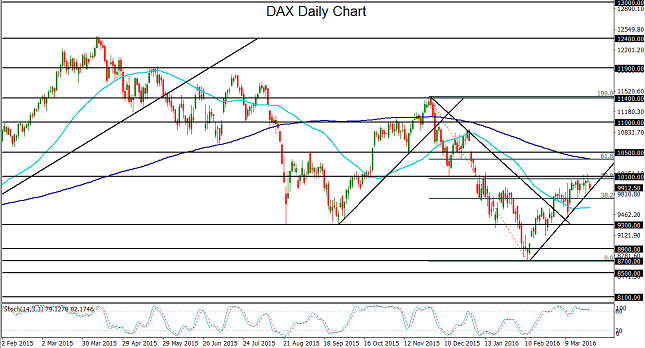![]()
Germany’s DAX index dropped along with other European and US equity indices on Thursday as commodities continued to show persistent weakness and the specter of a more hawkish Fed weighed on global stock markets. The DAX closed down nearly 2% on Thursday, exceeding losses suffered by its UK counterpart, the FTSE index.
For the past month-and-a-half, the DAX has been well-entrenched in a strong bullish rebound and recovery from February’s long-term lows around 8700. During the course of this rebound, the index has broken out above some major resistance factors, including the important 9300 level and the 50-day moving average. The most recent culmination of this short uptrend occurred earlier this week, when the DAX reached and then retreated from major resistance roughly around the 10100 level. That key level has been a relatively frequent pivoting point for the German index in the past. The 10100 level is also approximately in the vicinity of the 50% Fibonacci retracement of the last major bearish run from the 11400-area highs late last year down to the noted February lows around 8700.
After Thursday’s extended retreat from this resistance, the index has fallen back down to an uptrend support line that has defined the rebound and recovery for the past month-and-a-half. Currently sandwiched between this uptrend line to the downside and the noted 10100-area resistance to the upside, the DAX has arrived at a critical technical juncture. In the event of a breakdown below the uptrend line, price could once again revert back to the longer-term downtrend that has been in place for nearly a year. In this event, the key short-term target to the downside remains at the important 9300 support level. In the opposite event of a sustained breakout above 10100-area resistance, a clear further resistance level to the upside resides at the key 10500 level.

Recommended Content
Editors’ Picks
EUR/USD holds above 1.0700 ahead of key US data

EUR/USD trades in a tight range above 1.0700 in the early European session on Friday. The US Dollar struggles to gather strength ahead of key PCE Price Index data, the Fed's preferred gauge of inflation, and helps the pair hold its ground.
USD/JPY stays above 156.00 after BoJ Governor Ueda's comments

USD/JPY holds above 156.00 after surging above this level with the initial reaction to the Bank of Japan's decision to leave the policy settings unchanged. BoJ Governor said weak Yen was not impacting prices but added that they will watch FX developments closely.
Gold price oscillates in a range as the focus remains glued to the US PCE Price Index

Gold price struggles to attract any meaningful buyers amid the emergence of fresh USD buying. Bets that the Fed will keep rates higher for longer amid sticky inflation help revive the USD demand.
Sei Price Prediction: SEI is in the zone of interest after a 10% leap

Sei price has been in recovery mode for almost ten days now, following a fall of almost 65% beginning in mid-March. While the SEI bulls continue to show strength, the uptrend could prove premature as massive bearish sentiment hovers above the altcoin’s price.
US core PCE inflation set to signal firm price pressures as markets delay Federal Reserve rate cut bets

The core PCE Price Index, which excludes volatile food and energy prices, is seen as the more influential measure of inflation in terms of Fed positioning. The index is forecast to rise 0.3% on a monthly basis in March, matching February’s increase.